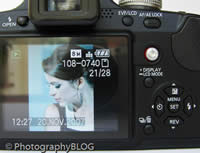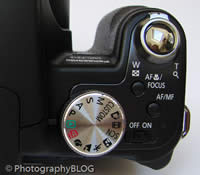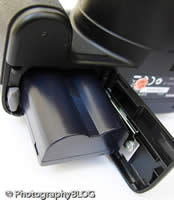Panasonic Lumix DMC-FZ18 Review
Review Date: December 3rd 2007
Author: Gavin Stoker
Leave a comment about this Review
|
Introduction

The defining feature of the new Panasonic Lumix DMC-FZ18 digital camera is its massive 18x zoom lens, equivalent to a very versatile 28-504mm focal length, which should cover virtually every imaginable photographic situation. The FZ18 is a bridge-style compact camera, looking just like a true DSLR at first glance, but featuring a non-interchangeable lens instead. The 8.1 megapixel Panasonic DMC-FZ18 also offers a 2.5inch LCD screen, an optical image stabiliser, face detection, RAW mode and ISO 1600 at full image resolution. There's a smart new Intelligent Auto mode which automatically selects the most appropriate combination of settings according to the situation, without any user input required. The Panasonic Lumix DMC-FZ18 has two other 18x zoom competitors - the Fujifilm S8000fd and the Olympus SP-560UZ. Does it have what it takes to reign supreme as the ultimate mega-zoom camera? Gavin Stoker found out...
Compare Prices
Support PhotographyBLOG: Buy the Panasonic Lumix DMC-FZ18 from one of our affiliate retailers:Ease of Use
As the debate rages on as to whether, with DSLR prices falling well within reach of the consumer, there is still a market for bridge cameras and so-called 'super zooms', Panasonic releases its own big hitting 18x optical zoom offering in the 8 megapixel Panasonic Lumix DMC-FZ18. Olympus was the first to offer an zoom on its SP-550 UZ, now replaced by the 560, and Fujifilm counter attacked with the FinePix S8000fd, so it seems that at least someone is still after a big zoom on a small-ish body. The theory is, when you've got such a lens reach and a smattering of real photographic control on board – albeit with a lot that is easy-peas-y point-and-shoot automatic as well – why would you need an interchangeable lens camera anyway?
As the Panasonic Lumix DMC-FZ18's asking price is £330 in the UK, however, a hard decision must be made. It's not such a financial stretch to the likes of the Nikon D40 or Pentax K100D Super instead at £399, and both can be found cheaper. Still, Panasonic's camera does offer the best of both worlds: 28mm equivalent at the wide end going all the way up to 504mm at maximum telephoto, allowing for (in theory) a very creatively flexible capture device. And, whether you already own a DSLR or not, anybody who has used an all-encompassing super zoom will appreciate that then swapping back to a 3x zoom – the range typically offered by digital compacts – is a frustrating experience. So I was glad to finally get my hands on an FZ18.
Available either in black or silver, the more serious-looking former version arrived on the PhotographyBLOG test slab, and boasts both a 'DSLR-lite' shape and styling. While resembling a diminutive DSLR, the Panasonic Lumix DMC-FZ18 is dominated by the inclusion of that lens, thankfully with on-board 'Mega O.I.S' (optical image stabilization). A by-product of its Venus Engine III processor is also subject motion detection, which in reality automatically increases both ISO sensitivity and shutter speed to prevent blur. Like other consumer Panasonics, you also get a high sensitivity mode that increases its maximum selectable ISO1600 to ISO6400 equivalent, but with a compensatory drop in resolution down to just 2MP. A stubby barrel encases and protects the optic when not in use and an equally good-sized grip with tactile, leather-effect detailing houses the lithium ion battery pack in its base. Nice to see a chunky lithium ion rechargeable battery fitted as standard when many bridge models seem to think that four bog-quality AAs will suffice to get you going out of the box.
While this is not a camera for slipping into a pocket by any means – being about twice the depth of Canon's recently reviewed 10x zoom PowerShot SX100 IS – itself unapologetically chunky compared with the average digital snapshot – the Panasonic Lumix DMC-FZ18 feels like it could withstand the odd glancing knock, though I wouldn't like to vouch for dropping it onto concrete. The camera feels solid and rugged in the palm, while at once portably lightweight – a slightly contradictory sounding summation that translates as build quality being 'as it should be'. Pleasing also to find a viewfinder – here electronic (EVF) – with an eye relief that juts out clear of the LCD so that you don't automatically smear your nose all over the monitor when you put your eye close to it. There's also a dioptre adjustment wheel immediately adjacent, enabling the short sighted to use it without clashing spectacles. To avoid flare, you also get a detachable lens hood in the box, and clip-on lens cap that you can attach via a thread to one of available catches for a shoulder strap.
 |
 |
| Rear Controls | Top Controls |
In being dominated by that big lens, the front of the camera is very spare looking, save for a lamp for the AF assist light/self timer to the right of the lens (if viewed head on), and above this three pin holes for the Panasonic Lumix DMC-FZ18's built-in speaker. Above the lens is a swift access pop up flash (with a dedicated activation button sitting just behind it at the rear), but no hot shoe for mounting a supplementary flashgun. Moving to the top of the camera, controls start to get a little busier, but not overwhelmingly so. Here you find a comprehensively featured mode wheel with 13 shooting options and one for playback. This demonstrates a nice firm action as you twist it around to your chosen setting, and a definite click as you line up each.
Ranged around the wheel are the usual suspects of program, aperture priority, shutter priority and manual modes, plus one for attributing custom settings, another for direct printing, movie mode, scene modes, night scene, sports, landscape, portrait and finally Panasonic's much talked about new Intelligent Auto Mode, which the company has boasted of being the 'ultimate auto mode.' Turn the dial to the latter and the camera automatically selects the mode that best suits your chosen subject – for instance point it at a flower and the camera will, in theory switch to macro mode. It's easy to be cynical but in practice this function actually works really well, allowing users to merely point and shoot and achieve better results than they could have dreamt of. Adjacent to the mode wheel is an on/off slider switch. Flick this to on and the camera powers up in around 1.5 seconds, the rear LCD bursting into life and that zoom extending to maximum wide angle setting, slightly proud of its protective barrel.
Although the Panasonic Lumix DMC-FZ18's AF is fast to determine focus and there's no shutter delay to speak of when you take a shot, and full 8MP resolution JPEGs are committed to memory in just over a second, take more than three regular stills in quick succession and the camera freezes up momentarily while the buffer memory is cleared. However, opt for a RAW file in single shot mode and you'll be twiddling your thumbs for up to 12 seconds while it's saved, while RAW + JPEG necessitates a tea-brewing 15-second delay – if saving to the built in memory that is. By inserting an (optional) SD card I managed to more than half these write times.
Just forward of the on/off slider is a small button marked AF/MF that allows manual adjustment of the AF area or the focus range to be manually set at between 1ft and infinity, the central portion of the frame enlarged so sharpness can be more accurately determined. Again, it does the job it's supposed to do. Just forward of this again is a dedicated macro AF button – useful should you be shooting for example in anything other than Intelligent Auto mode – and just in front, at the start of the slope that forms the top of the camera grip, the main shutter button. Springy to the touch, this is encircled by a lever for operating the zoom, the action of which is impressively smooth and mechanically quiet, though sadly it is disabled when you're using the video mode. While not unusual, it's a real pity given the impressive focal range on offer. Picture and sound quality is however better than average.
Moving around to the back of the Panasonic Lumix DMC-FZ18, we find the left hand side dominated by a 2.5-inch, 207k pixel LCD monitor, which is bright and clear as a means of composition whether shooting inside or out. If visibility does suffer in sunlight – not something we personally found a problem – there's the option to switch to the electronic viewfinder via a dual EVF/LCD button, though 90% of the time the LCD was the preferred method of composition. Just right of the viewfinder, like you'd find on a budget DSLR, is an AF/AE lock button, below which is an easy-to-overlook joystick, though it's so small and slightly fiddly that it should perhaps be renamed the 'joy-less' stick. Press this down, hold it, and a pull down menu containing a smattering of useful settings appears on screen to save you having to delve into the main menus for similar. This enables on-the-fly access to an Aladdin's cave of options, including the important likes of image stabilization mode – a choice of two modes (activated at the time you press the shutter or on continuously) – auto focus areas (or opt for face detection mode), metering (spot, centre weighted and average), manual white balance, ISO, image resolution and image quality.
 |
 |
| Memory Card Slot | Battery Compartment |
Beneath this stubby 'stick' is a dual-purpose button clearly marked display and LCD mode. A quick press either activates or deactivates the number of shooting settings displayed on screen, calls up a live histogram alongside them or displays a nine zone compositional grid for those experimenting with the Rule of Thirds. Holding the button down for longer will call up the LCD mode options; like other Panasonic Lumix compacts you get the choice here to brighten the overall display ('power LCD' mode) or opt for the more useful high-angle setting, which aids screen visibility when you're holding the camera at arm's length for a shot over the heads of a crowd. Below this control is an identically sized button marked with the familiar trashcan icon for deleting unwanted shots quickly. This button also serves a dual purpose as a short cut to continuous shooting (two fairly average settings: 'normal' or unlimited – the former at up to 3fps, the latter 2fs to the maximum capacity of the card).
To the right of this we discover the familiar four-way control pad that you'd expect to find on most digital cameras. At its heart is a menu/set button, for, yes, calling up the user-friendly if uninspired looking regular menus on the LCD screen. The menus comprise two separate folders; one for shooting/playback options – dramatically pared down if you're using Intelligent Auto mode – the other the generic set up menu. A subsequent press when you've located the various options goes on to effect any changes, which are quick and precise. Ranged around this central menu/set button are four pads. Although these are used for tabbing through menu options or captured images, press them when in capture mode (and you haven't summoned up a menu) and, starting from the top, you find an exposure compensation button. Continue clockwise and you find one for accessing the flash settings, a third for quick review of an image without leaving the particular capture mode (with the effective ability to zoom in up to 8x to check detail), while the fourth provides access to the self timer options.
At the base of the camera we find a screw thread for a tripod, alongside which is a sliding compartment that houses both the chunky rechargeable battery – necessarily providing a good long life as there's no optical viewfinder to fall back on as a power saver – and a slot for an optional SD card (or the higher capacity SDHC). Apart for a slot for threading through a strap, the right hand side of the camera is a continuation of the grip, so is devoid from any controls or compartments. The left hand side of the unit (if viewed from the back) features a flip open door hiding the AV out port and DC-in. A Lumix-branded charger is provided in the box for removing and boosting the aforementioned lithium cell.
Though the Panasonic Lumix DMC-FZ18 requires some degree of familiarization and patience to fully get to grips with the range of features on offer – simply because you don't find all of them located where you might expect, and, yes, that joystick is rather fiddly to operate – that won't prevent you from taking photographs from the get go; largely because the Intelligent Auto Mode is so reliable. The FZ18's overall size and handling feels right – it's responsive and, even if some controls do require fingertip operation and precision, that's no less than we're used to by now for a piece of consumer electronics.
|
![]() PhotographyBLOG
is a member of the DIWA
organisation. Our test results for the Panasonic Lumix DMC-FZ18 have
been submitted to DIWA
for comparison with test results for different samples of
the same camera model supplied by other DIWA
member sites.
PhotographyBLOG
is a member of the DIWA
organisation. Our test results for the Panasonic Lumix DMC-FZ18 have
been submitted to DIWA
for comparison with test results for different samples of
the same camera model supplied by other DIWA
member sites.
